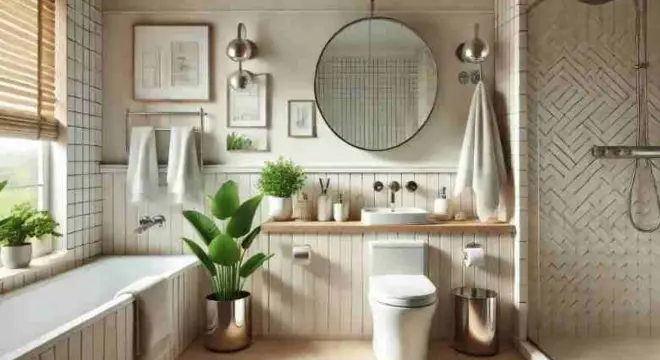How Much Does a Bathroom Renovation Cost in U.S ? [2024 Guide]?
Are you wondering how much it really costs to renovate a bathroom in India?
Striking the right balance between quality and affordability can feel overwhelming, especially when hidden expenses come into play.
This guide covers everything you need to know about bathroom renovation costs in U.S for 2024—from regional price variations to detailed budgeting strategies—to help you plan your dream renovation.
Factors That Influence Bathroom Renovation Costs?
When planning a bathroom renovation, knowing what drives the costs can help you budget effectively and avoid surprises. Here’s a breakdown of the main factors:
1. Size of the Bathroom
The size of your bathroom plays a major role in determining the cost. Here’s why:
- Small Bathrooms (e.g., 5×7 ft): These are easier and cheaper to renovate because they require fewer materials (like tiles) and less labor. A basic upgrade can cost anywhere between ₹50,000 and ₹1,00,000.
- Larger Bathrooms (e.g., 8×10 ft or more): Larger spaces mean more materials, more labor, and often more complex work. If you’re adding luxury features like a bathtub or custom lighting, the cost can easily go over ₹1,50,000.
Tip: Measure your bathroom accurately and decide which areas truly need renovation to keep costs manageable.
2. Extent of Renovation
The scope of your renovation determines how much you’ll spend.
- Cosmetic Updates: These are surface-level changes like painting, changing light fixtures, or installing new cabinet handles. They are quick and cost-effective, ideal for budget-conscious renovations.
- Full Remodeling: This involves replacing old plumbing, tiles, and electrical systems, or changing the layout of the bathroom. It’s more expensive because it requires skilled labor and specialized materials.
Example: If you’re just changing the wall color and replacing faucets, you might spend ₹20,000–₹50,000. But if you’re tearing out old tiles and redoing the plumbing, expect costs to exceed ₹1,00,000.
3. Materials Used
The type and quality of materials can make a big difference in your budget.
- Budget Materials: Ceramic tiles, basic faucets, and local or non-branded products are more affordable. For example, ceramic tiles can cost as low as ₹25 per square foot.
- Premium Materials: If you prefer vitrified tiles, marble countertops, or branded fixtures like Jaquar and Kohler, the cost increases significantly. Vitrified tiles can cost up to ₹2,000 per square foot, and premium shower systems might set you back ₹50,000 or more.
Tip: Mix budget and premium materials strategically—choose branded items for essential fixtures like taps and showerheads, and save on things like wall tiles.
4. Labor Costs
Labor costs are often overlooked, but they can take up a significant portion of your budget.
- In Metro Cities (e.g., Mumbai, Delhi, Bangalore): Labor rates are higher, ranging from ₹200–₹400 per square foot. This includes plumbing, tiling, and installation work.
- In Smaller Cities: Labor costs are slightly lower, around ₹150–₹250 per square foot.
Why it matters: Labor costs include not just installation but also the time and skill required for tasks like waterproofing and plumbing. Always confirm labor charges in advance to avoid surprises.
5. Additional Features
Adding modern or luxury features can quickly drive up renovation costs. For example:
- Rain Showers and Bathtubs: These can cost ₹30,000–₹1,00,000 depending on the brand and design.
- Smart Bathroom Mirrors: With features like lighting and anti-fog systems, they cost around ₹10,000–₹25,000.
- Custom Storage Cabinets: These can cost ₹5,000–₹20,000 depending on the material and design.
Pro Tip: Decide which luxury upgrades add real value to your bathroom and prioritize them. Not every bathroom needs a bathtub or smart mirror.

Regional Cost Variations in the U.S.
Bathroom renovation costs can vary a lot depending on the region. In the U.S., for example, the Department of Commerce has shared information showing how costs are different in various areas. These differences happen because of things like local labor costs, availability of materials, and the overall economy of that area.
Even in countries like India, similar factors like labor rates and material costs affect how much a renovation might cost in cities like Mumbai, Delhi, or smaller towns
Detailed Cost Breakdown
1. Plumbing and Electrical Work
- Average costs per square foot or job.
- Hidden costs like rewiring or replacing old pipes.
2. Flooring and Tiling
- Cost range for tiles (₹25 to ₹2000 per sq. ft.).
- Labor charges for installation.
3. Fixtures and Fittings
- Budget vs. premium brands.
- Pricing for essentials like faucets, sinks, showers, etc.
4. Waterproofing and Painting:
- Importance of waterproofing and associated costs.
For understanding better breaking down these expenses in detail in case of renovation, the Cost Breakdown Structure (CBS) is one of the reliable approaches. It clearly subcategorizes total renovation costs into labor, material, and installation costs- among others.
Hidden Costs and Contingencies
This is the part that includes hidden costs and contingencies that come along when renovating a bathroom. There is always an unplanned expense or two that needs to be remedied while going through the renovation process. So you better set aside extra money in your budget for these unforeseen costs. Some of the common hidden expenses include:
1. Mold or Dampness Repair
During a renovation, if mold or dampness is found in the walls or floors, it needs to be repaired, which can add unexpected costs.
2. Waste Disposal
Renovation projects often involve removing old materials like tiles, pipes, and fixtures, which requires waste disposal services, adding to the total cost.
3. Emergency Plumbing Fixes
Sometimes, plumbing issues such as burst pipes or leaks can occur during renovations, which need to be fixed urgently, leading to extra costs.
Budgeting for Contingencies
It’s essential to set aside 10-20% extra of your total renovation cost to cover any unexpected expenses.
For more information on managing unforeseen project expenses, check out this guide on unforeseen project expenses.
Sustainable and Eco-Friendly Renovation Ideas?
1. Cost-Effective Eco-Friendly Materials
Choose materials that are sustainable yet affordable, such as bamboo, recycled tiles, or reclaimed wood. These options are not only eco-friendly but can also be more cost-effective in the long run.
2. Energy-Efficient Fixtures
- LED lights use less energy and last longer than traditional bulbs.
- Low-flow faucets and showerheads reduce water usage, lowering both water bills and environmental impact.
3. Long-Term Cost Savings from Sustainable Options
Investing in eco-friendly materials and energy-efficient fixtures can lead to significant savings over time. Lower energy bills, reduced water consumption, and durable materials that last longer make these options both environmentally and financially smart choices.
DIY vs. Hiring Professionals
When to DIY
Some tasks are simple and don’t require expert skills. These are great for DIY:
- Cosmetic upgrades: For example, painting walls or replacing light fixtures.
- Simple decor updates: Changing mirrors, adding shelves, or updating accessories.
When to Hire Professionals
There are certain jobs where the expertise of a professional is crucial:
- Plumbing: Issues like pipe repairs or installations require a plumber’s skills.
- Tiling: Laying tiles, especially for floors or intricate designs, is best left to experts.
- Major structural changes: Any renovation that involves moving walls, electrical work, or other major changes should be handled by professionals for safety and accuracy.
Pros and Cons of Both Approaches
DIY Pros
- Cost-saving: You save on labor costs.
- Control: You have full control over the project and can work at your own pace.
DIY Cons
- Time-consuming: DIY tasks can take longer than expected.
- Skill limitations: If you lack the right skills, mistakes can be costly.
Professional Pros
- Expertise: Professionals bring years of experience and ensure quality work.
- Efficiency: Jobs get done faster and with fewer errors.
Professional Cons
- Cost: Hiring professionals can be expensive, depending on the complexity of the job.
- Coordination: You’ll need to manage schedules and communicate with contractors.
Financing and Budgeting Tips
How to Set a Realistic Budget
Setting a realistic budget is crucial for staying on track during a renovation. Here’s how to do it:
- Estimate costs: Start by getting quotes for materials and labor.
- Include all expenses: Don’t forget hidden costs like waste disposal or unexpected repairs.
- Add a contingency: Set aside 10–20% extra to cover unforeseen costs.
- Prioritize: Decide which renovations are essential and which can be postponed.
Financing Options:
There are several ways to finance your renovation:
- Home Renovation Loans: These loans are specifically designed for home improvements. You can choose from secured or unsecured loans based on your financial situation.
- Home Equity Line of Credit (HELOC): If you have equity in your home, this option lets you borrow against it, usually at a lower interest rate.
- Personal Loans: If you don’t have home equity, a personal loan can provide funds with a fixed interest rate.
- Credit Cards: For smaller renovations, using a credit card might work, but be mindful of high-interest rates.
Tips to Avoid Overspending:
- Stick to the budget: Always compare quotes and keep track of your expenses as you go.
- Shop smart: Look for sales, discounts, or used materials that still meet your quality standards.
- DIY when possible: Save on labor costs by doing simple tasks yourself, but be careful not to overestimate your abilities.
Maintenance and Long-Term Costs
1. Cleaning and Maintenance Requirements for Different Materials:
Different materials require varying levels of maintenance:
- Tiles: Regular cleaning and occasional re-grouting to prevent buildup.
- Wood: Needs periodic sealing and careful cleaning to avoid water damage.
- Granite or Marble: These require sealing to maintain their appearance and avoid stains.
- Glass: Glass shower doors and mirrors need frequent cleaning to prevent water spots.
2. Tips for Keeping Your Bathroom in Good Shape Post-Renovation:
- Regular cleaning: Establish a routine for cleaning to prevent mold, soap scum, or mildew buildup.
- Check for leaks: Periodically inspect plumbing to catch leaks early.
- Ventilation: Keep the bathroom well-ventilated to prevent moisture damage and mold growth.
- Touch-ups: Make minor repairs as soon as you spot issues to avoid larger, more costly repairs.
Conclusion
In summary, bathroom renovations can significantly improve the look and functionality of your space. By planning carefully, setting a realistic budget, and making informed decisions about materials and labor, you can ensure your renovation is a success. Consider the long-term maintenance costs and return on investment (ROI) to make choices that will benefit you in the years to come.


